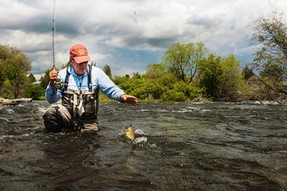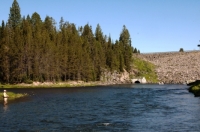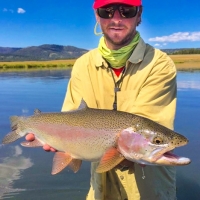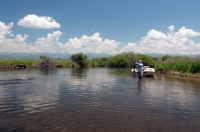
Moving into August is a good time to reflect on the season and look ahead to what we might expect moving forward. I must be honest, at the end of April I was very apprehensive about the upcoming season. I was anything but optimistic. Our snowpack had moved from near normal at the start of the year to less than 50%. On top of that March and April were very dry with above normal temperatures. Even though our carryover in the reservoirs was good the irrigation season started almost a month early. All indications were that the Island Park Reservoir would be completely drained by the end of the irrigation season in September. I’ve seen it before and I know what to expect; dirty, turbid water flowing through the Box Canyon all the way to Ashton. This looked to be the driest year we’ve had since the 1930s!
Early season produced exceptional fishing on the Lower Henry's Fork
We got a reprieve in May. Rainfall in May was almost 300% above normal. That helped immensely cutting down irrigation demand and keeping water in the reservoirs. The result of low irrigation demand was very low releases from the Island Park Dam. We heard a lot of bitching from local anglers about the low water as the release from Island Park fell to just over 300 cfs on May 29th and remained there until June 10th. The normal flow from Island Park in early June is almost 1000 cfs. By mid-June when the Ranch opens the flow from Island Park usually declines until storage water is released in July.
The Upper Henry’s Fork, Fall River and other tributaries usually provide enough natural flow for irrigation needs without having to rely on reservoir storage. Irrigation demand doesn’t normally draw on reservoir storage until early to mid-July. This year it started on June 10th. Unfortunately the wet weather in May wasn’t enough as warm dry weather in early June resulted in irrigation demand for water that just wasn’t there. The normal flow for Fall River above the first diversion is about 2500 cfs in early June and remains above 2000 cfs until late June. This year it started at just below 2000 cfs the first of June and steadily declined until it leveled off at 600 cfs on June 25. That left a gap of about 1400 cfs that had to come from somewhere.
On June 15th anglers were elated at an optimum flow of just over 1000 cfs. I did not share their optimism. It was the best opening week we’ve seen in the Ranch in years but releases from the dam kept increasing every few days until the flow reached almost 1700 cfs by the end of the month. It stayed there until July 10th when it started to come back down. Even at such high flows the fishing was excellent until the water started to get dirty in early July. Such high flows started sediment moving through the Island Park Dam into the Box Canyon. The turbidity was likely caused by a buildup of fine material above the outflow of the dam that was flushed out. In most years peak June outflow hovers around 1000 cfs. The hydro facility at the dam operates at maximum capacity of about 950 cfs so the water flowing out of the regular outflow has been low. This year was different. I’ve seen worse than this. In 1984 the streamflow at Island Park was almost 2400 cfs for more than 40 days. The Henry’s Fork Foundation has been monitoring the turbidity both in the reservoir and the river below. The results should be available in about a week but preliminary indications are that most of the material is organic which should not have a negative impact on the health of the fishery.
Water normally doesn't flow through the spillway tunnel unless the flow is more than 950 cfs

To top everything off the power company that owns the hydroelectric project at the Chester Dam required a maximum flush of over 2300 cfs to test their turbines. They were able to do this with the blessing of the Fremont Madison Irrigation District. Originally the flush was scheduled for June 21st. Thankfully the Henry’s Fork Foundation was able to negotiate with the powers that be to postpone this until July 21st. I can only imagine what would have happened if it had occurred on the original scheduled date. The flush continued for 2-1/2 days. Other than screwing up the fishing for a few days the negative affect appears to be minimal. In fact the higher flows really helped out the fishing on the lower river. It also likely flushed more of the debris and sediment that had collected over the years above the Island Park spillway. I realize that a lot of people have been pretty frustrated with the flush and the streamflow regime this summer. I’m frustrated too but the reality is the deck is stacked against us. Idaho law does not provide water rights for fish and wildlife. The law favors irrigation and power generation. I well remember the days before the Henry’s Fork Foundation was organized when there was little concern for the fishery. I’m sure things could have been a lot worse.
After the big flush the big rainbows started showing up on the Ranch

Another issue has been keeping enough water in the river at St. Anthony. They try to keep at least 1000 cfs flowing to maintain this valuable fishery. That has not been easy to do. While the flow out of Island Park reached 1600 cfs, the flow at St. Anthony stayed at or below 1000 cfs. As of this writing the flow hovers near 600 cfs. In past years I was on the phone whenever the flow dropped below 1000 cfs. However, this year I have had to bite my lip. There just isn’t enough water to go around. So far the temperature has been mild enough to keep the water from heating up too much.
One benefit from the early irrigation season has been that barley and other crops have ripened several weeks early. This has lessened the demand for irrigation. With that in mind the flows from Island Park have been cut back to less than 800 cfs. Average flow for this date is about 1300 cfs. This should help keep more water in the reservoir which might avoid another sediment flush which almost always occurs when the reservoir gets below 20% capacity. Timely rain between now and the end of the irrigation season could really help.
The situation has been better on some of our surrounding waters. Early this spring I was also concerned about the South Fork below Palisades Reservoir. When it gets drawn down too low it hurts all of our waters. Fortunately the snowpack was a little better in that drainage. In fact the South Fork has fished better than we can remember for many years. The moisture we received in May also benefited the Teton River. The water received in May collected as snow in the high elevations of the Teton Range. The streamflow has been below normal but water temperatures have remained low and the fishing has been excellent.
The Upper Teton River has fished well throughout the season

This has been a year for us to be very thankful that we are one of only two outfitters in the State of Idaho with legal outfitting permits to guide on the Henry’s Fork, Teton, South Fork, Madison and Yellowstone Park. Our guides have found great fishing for our clients throughout the season but sometimes they’ve had to do a little driving to find it. Hopefully we’ve dodged a bullet. Barring a long hot dry spell over the next four weeks we should get through the remainder of the season somewhat unscathed, something I wouldn’t have bet on last June. After that we’ll have to hope for a good snowpack this winter.
I want to make clear that my position and outlook on the water situation is based on more than 40 years in this business. It has really been a balancing act for water managers trying to keep as much water as possible flowing at St. Anthony while trying to keep as much water as possible in Island Park Reservoir. For more accurate information I urge you to focus on the Henry’s Fork Foundationwebsite and Facebook page. They’ve got things down to a science. I’m not a scientist. I’m just an old outfitter.